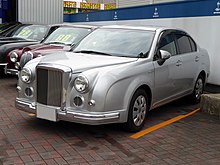Retro style
Retro style is imitative or consciously derivative of lifestyles, trends, or art forms from the past, including in music, modes, fashions, or attitudes.The term retro has been in use since 1972 to describe[1] on the one hand, new artifacts that self-consciously refer to particular modes, motifs, techniques, and materials of the past.[7] In Simulacra and Simulation, French theorist Jean Baudrillard describes retro as a demythologization of the past, distancing the present from the big ideas that drove the modern age.These objects used to be seen as junk: Victorian enamel signs, stuffed bears, old furniture painted with union jacks, bowler hats etc.The introduction of the technique of photocomposition in the 1960s allowed typographers greater flexibility in the selection and arrangement of type styles and sizes.[18] Historicist styles are also used in the promotion and packaging of food and household products, referring to childhood memories and domestic nostalgic ideals.[22] A famous example of a retro pop-art character is the more generalized form of the Ward Cleaver-styled J. R. "Bob" Dobbs-esque icon which has been widely played off, copied, and parodied.A handful of airlines have chosen to paint a historical livery on a single selected aircraft in their modern fleet, typically as a marketing device or to commemorate an anniversary.






Retro (disambiguation)penny farthingnostalgia cyclepopular culturehistoricismRomantic generationsModernityCharles de GaulleWorld War IIJean BaudrillardobjectsnostalgiaMitsuokahybridantiquesInterior designgraphic designWilliam MorristypographyclassicismpackagingKarlie KlossAnna Suimom jeanshipstersDr. Martenspop artpressesAnne Taintortelevision programsWard CleaverJ. R. "Bob" DobbsMothers of InventionCruising with Ruben & the JetsSha Na NaAmerican GraffitiM*A*S*HGreaseHappy DaysPeggy Sue Got MarriedRetrogamingvideo gamesvintage computersconsolesCommodore 64Amiga 500Atari 2600Sega Genesis/Mega DrivePlayStationNintendo 64DreamcastGame BoyEmulationQantasBoeing 737-800Sydney AirportairlinesliveryaircraftShowa retroShowa eraList of retro style video game consolesList of retro-style digital camerasRetrofuturismRetrotronicsRetro-style automobileSteampunkThrowback uniformVintage (design)Reaktion BooksBaudrillard, JeanCollins, James CEco, UmbertoRoss, AndrewSamuel, Raphael
